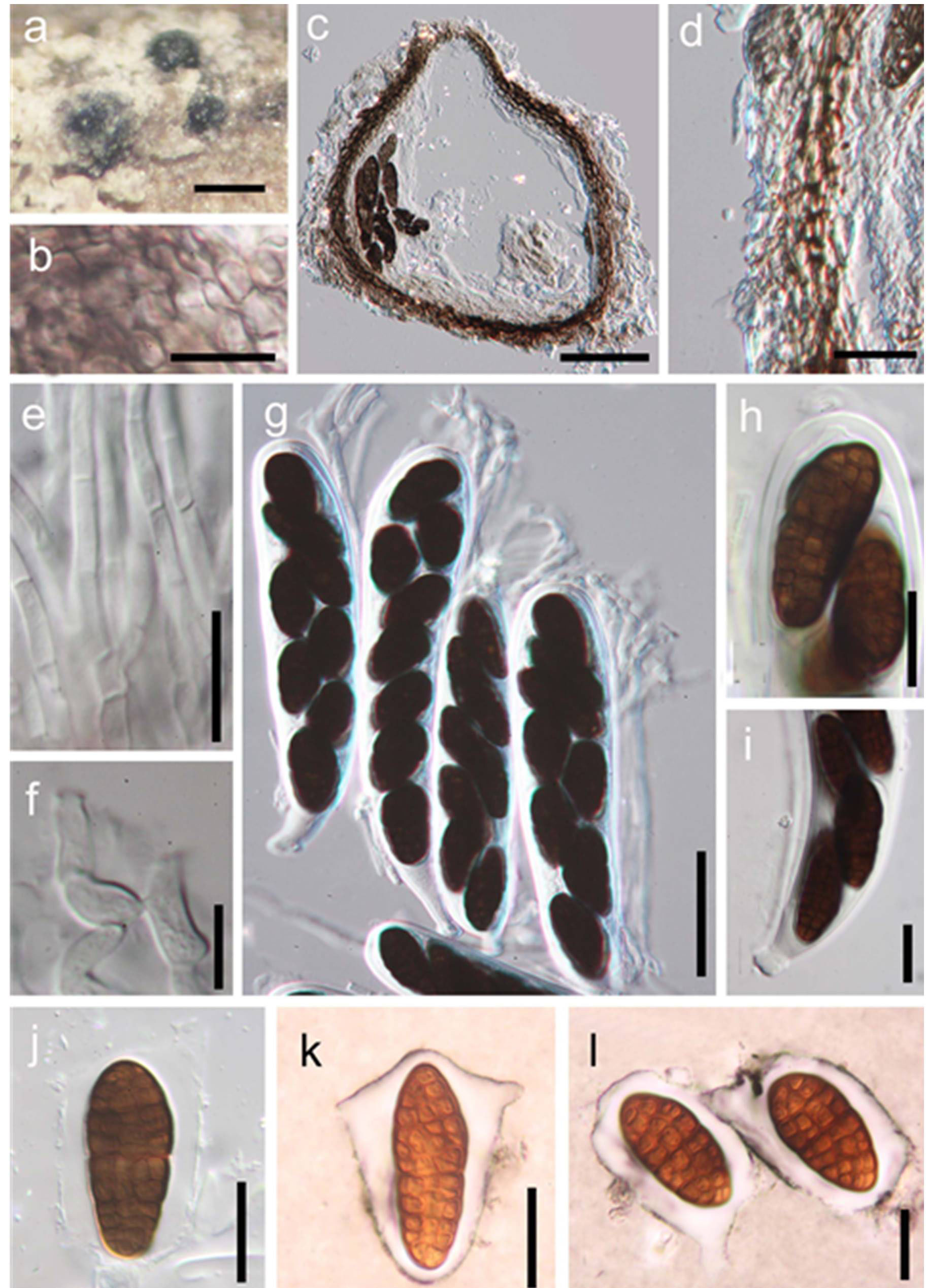Decorospora gaudefroyi (Pat.) Inderb. et al., in Inderbitzin et al., Mycol. Progr. 1(4): 657 (2002)
Basionym: Pleospora gaudefroyi Pat., Tabl. analyt. Fung. France (Paris) 10: 40 (no. 602) (1886)
= Pleospora salsolae Fuckel var. schoberiae (Sacc.) Sacc., Syll. fung. (Abellini) 2: 248 (1883)
≡ Pleospora schoberiae (Sacc.) Berl., Icon. fung. (Abellini) 2: 23 (1895)
= Pleospora lignicola J. Webster & M. T. Lucas, Trans. Br. mycol. Soc. 44(3): 431 (1961)
= Pleospora salicorniae Jaap, Verh. Bot. Ver. Prov. Brandenburg 49, 16. 1907 (non Pleospora salicorniae P. A. Dang. 1888)
= Pleospora herbarum var. salicorniae Jaap, Annls mycol. 14(1/2): 17 (1916).
Saprobic on dead wood in marine habitats. Sexual morph: Ascomata perithecioid, small, 200−250 µm in diam., globose to subglobose, immersed to erumpent, becoming superficial on the substrate at maturity, carbonaceous, black, solitary or several clustered, short ostiolate, papillate. Ostiole central, short, brown to black. Peridium thin, composed of thick-walled cells, forming a textura angularis in both surface view and longitudinal section, up to 12 µm. Hamathecium of 2 µm wide, hypha-like, cellular, septate, branched pseudoparaphyses anastomosing above the asci. Asci 80−125 × 15−25 µm (= 104 × 18 µm, n =10), 8-spored, bitunicate, fissitunicate, clavate, short pedicellate, thick-walled with large lumina, apically rounded with a clear ocular chamber. Ascospores 20−25 × 7−10 µm (= 21.2 × 9 µm, n =10), biseriate, ellipsoidal, brown, 6−7 transverse septa and 2-3 longitudinal septa in each segment, slightly constricted at the centre transverse septum, muriform, covered by a gelatinous thick sheath with 2 or rarely 3 extensions. Asexual morph: unknown.
Material examined: France, Marais de la Pointe de Touquet, near Etaples, on Suaeda maritima, 15 Aug. 1879, O. Hariot (PC 0084490, holotype)
Notes: Decorospora gaudefroyi (Pat.) Inderbn et al., is a marine ascomycete firstly described as Pleospora gaudefroyi Pat. from northern France in 1886 and described by Kohlmeyer and Kohlmeyer . Yusoff et al. described the ascospores of P. gaudefroyi at the ultrastructural level without the unfolded sheath extensions. Based on a partial SSU and ITS ribosomal DNA transferred P. gaudefroyi to a new genus Decorospora, as it did not group in Pleospora. Morphological characters of D. gaudefroyi include black, erumpent ascomata becoming superficial on the substrate at maturity, septate and branched pseudoparaphyses, fissitunicate, clavate asci with thick wall, as well as yellow-brown ascospores with seven transverse septa and 1-3 longitudinal septa in each segment enclosed in a gelatinous sheath with a tripartite outer boundary. The characterized sheath makes it easy to distinguish from any other marine ascomycetes. D. gaudefroyi was considered to be a synonym of Pleospora herbarum (Fr.) Rabh. which is the type species of Pleospora . However, the presence of the ascospore sheath with its apical extensions and its marine habitat distinguish it from other marine Pleospora species . Decorospora is placed in Pleosporaceae, well-supported by partial SSU and ITS ribosomal DNA sequences .
During our phylogenetic analysis, the type strain of Decorospora gaudefroyi (pp4723) forms a roubust clade basel to Comoclathris. Furthermore the putative strains of Pleospora sp. ATCC MYA-3203 and Pleospora sp. ATCC MYA-3202. Thus we renamed them as Decorospora sp. in this study.
Fig. 1 Decorospora gaudefroyi (PC 0084490). a. Ascomata on the host surface. b. Peridium cells from surface view. c. Section of ascoma. d. Peridium. e-f. Branched pseudoparaphyses. f-g. Young asci amongst pseudoparaphyses. h. Tip of the ascus. Note the clear ocular chamber. i. Pedicellate ascus base. j-l. Ascospores. k-l Ascospores stained with Indian ink. Note the sheath. Scale bars: a = 300 µm, b = 10 µm, c = 50 µm, d−e = 10 µm, f = 5 µm, g = 30 µm, h−l = 10 µm.

